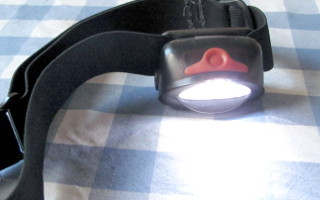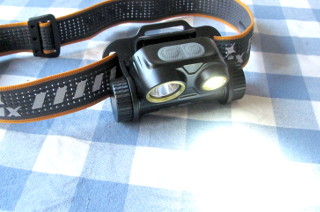<HOME
<Hiking
Fenix HM65R SuperRaptor headlamp
No, its maximum runtime is not 300 hours!
You need a headlamp when hiking. Sure, midsummer in Lapland doesn't get
real dark ever, but on occasion you may be staying in a wilderness hut
without huge windows, or stuck inside a tent on a dark and rainy day, and
want a bit of extra light to read by. Also, the Sun does actually begin to
set already around the end of July. And a headlamp is much more convenient
than a hand-held flashlight, so that's what I prefer.

|
For over 20 years I used a simple Petzl Tikka (or maybe
"Tikka Plus", I forget) with a row of four standard white
LEDs, running off 3×AAA batteries, with a single button to switch
between high, medium, low and flashing modes, as well as off.
The Tikka served me well. Mostly I just used its low setting
while reading, or high when searching for some lost object. Neither one
was especially bright—but on the other hand, a single set of batteries
easily lasted a six week hike. However, as the batteries wore down, all
modes would gradually get dimmer and dimmer. Occasionally I did wish for
more light, e.g. on the rare occasion when looking for a flat space
for my tent in the dark.
The PWM flicker at low brightness was just noticeable with the
Tikka. It made falling droplets of liquid fascinating to watch
at night.
|

|
Finally I went ahead and upgraded to a more modern headlamp, the
ridiculously powerful and overly fancy Fenix
HM65R SuperRaptor. It has two LEDs, one of which gives a wide
floodlight with Low, Medium and High modes, the other gives a narrower
spotlight beam with Low, Medium, "High I",
"High II" and "Turbo" modes. (Since a turbo is an
air compressor used in internal combustion engines, it is an entirely
logical name for a lamp's brightness setting, right?) The two LEDs have
their own buttons and the interface is sensible: long press to switch on
and off, short press to cycle through the brightness settings. The light
remembers which setting was last used on each LED, and either LED or both
can be used. There's also a lockout mode to prevent the light accidentally
switching on and eating up the battery. I don't see any PWM flicker or
hear any SMPS whine in any of the operating modes.
The lamp has a normal headband just like the Tikka, plus another
one across the top. The latter may be good e.g. when running or
otherwise bouncing around, but I didn't like it (or need it) so I simply
removed it (nondestructively).
On a longer hike, I mostly just use the lowest floodlight setting for
reading. On that setting, the lamp is advertized to have a runtime of
300 hours, but that doesn't seem to be true. I only got
about half of that in my test. But it
is a respectably long runtime regardless.
|

|
The wide floodlight of the SuperRaptor is wider and more uniform than
the Tikka's, which is nice. The Tikka is also incredibly
blue, but of course that's really obvious only in a side-by-side
comparison. The SuperRaptor is a bit on the greenish side, also not
really obvious in actual use. The photo here
was taken with daylight white balance, the SuperRaptor on low power
floodlight quite close to the furry cow on the right, the Tikka
on high power and placed quite a bit further back from the baby moose on
the left, in order to make both beams roughly the same size.
Yeah, the lowest setting of the SuperRaptor seems to actually
produce more light than the brightest setting of the
Tikka! Can that be right??? Or have the Tikka's LEDs degraded
that much over two decades of use? About time I
got a new headlamp! :)
|
150 hours runtime (not 300 h!)
So how's the runtime on the SuperRaptor? I'm interested primarily in
its lowest power setting with the advertized 300 hours runtime,
so that's
what I tested: I charged the battery, and then basically left the light
switched on at low power floodlight whenever I was awake during eight days,
occasionally checking the battery status indicators and recording whenever
there was a change. Here are my results:
| Time | Indicator status (% capacity according
to manual) |
| 0 h | Start test, 4 indicators
(100% charge) |
| 28 h | 3 indicators (80% charge) |
| 53 h | 2 indicators (60% charge) |
| 76 h | 1 indicator (40% charge) |
| 135 h | 1 indicator blinking (20% charge),
|
| 147 h | 1 indicator blinking constantly
("recharge immediately") |
| 155 h | All indicators off, end test |
With one indicator blinking constantly, the battery voltage was 3.00 V
exactly. That's pretty much empty for a Li-Ion cell. The lamp is supposed
to prevent overdischarging, so I still left the lamp on, until the blinking
indicator had gone out, and the light was also visibly dimming. At that
point the voltage was only 2.56 V, verging on overdischarge, so that's
where I ended the test. There's less than 1% of charge left at that point,
yet I had clocked only 155 hours—nowhere near 300!
What gives???
Could the battery be bad? I charged the battery in my SkyRC MC3000
battery charger/analyzer (to 4.20 V with 100 mA cut-off current),
and did a full discharge test (to 3.00 V),
which yielded 3185 mAh—not quite the
stated 3500 mAh capacity, but well in the ballpark. (Advertized capacities
always tend to be optimistic, and are possibly tested to unhealthy extremes
of overcharge and -discharge.) So why the short runtime? Doesn't the lamp's
internal charger charge the battery fully? To test that, I charged the
empty battery overnight in the lamp, which left the battery at 4.14 V.
Then I did a full discharge test in the SkyRC
charger, which yielded 3109 mAh, pretty close to the previous
result. So the lamp's onboard charger is working just fine as well.
I contacted the retailer Varusteleka,
and inquired if they have any knowledge of this issue. They did not, but
were appropriately concerned about the perfomance of the product they sell,
and offered to exchange my lamp for another one of the same model,
and send the first one to the manufacturer for analysis. (That's what I call
service! Maybe I could have bought the SuperRaptor elsewhere for a 1%
cheaper price, but Varusteleka's customer service is always top notch!
Also, dealing with manufacturers directly is sometimes frustrating, so I'm
very happy Varusteleka took care of that on my behalf. Still waiting to hear
the manufacturer's comments.) So then I tested the replacement unit's battery
and got
3268 mAh—very close to the previous one. Then I did the same
runtime test, and got 10 hours more—but still nowhere near the
advertized 300 h!
So what could be the problem? It seems that the SuperRaptor
is some wacky "special edition" model of the HM65R that's
only available in Finland (wtf???), and one of the major differences
between the two is that the standard HM65R is designed to slowly
decrease the lamp's brightness during use—claiming that your eyes will
adapt and never notice the change. That increases the runtime numbers
significantly, but many people seem to hate this feature.
The SuperRaptor model does not do this, though it is otherwise
pretty much identical. So could it be that
Fenix's marketing division simply forgot to update the numbers for
the SuperRaptor's sales blurb? There are odd discrepancies in
the specified runtimes of higher power levels as well, but I never tested
those so thoroughly. I also noticed that, with a single blinking indicator
left, the three brightest spotlight modes became equal in
brightness—the lamp begins to limit the highest power levels before the
battery is completely depleted. That's quite reasonable in my opinion.
Update:
There now seems to be a new model, the upgraded
HM65R SuperRaptor 2 (also available only in Finland,
wtf?). Its maximum runtime at the lowest
power setting is quoted as only 200 h! You don't normally see
performance specs lowered when a new model is introduced, do you?
(The maximum brightness was increased to 1500 lumen from the
old 1400. You must improve something to sell it!) But it would
seem the old 300 h spec was bunk all along! Mind you, I didn't get
even 200 h in my tests with the old model, but at least this value is
closer to the truth, or maybe they've managed to lengthen it somewhat
e.g. by further decreasing the brightness (although both claim the same
8 lumen for it). It is shipped with the same battery as the original
SuperRaptor. Go figure.
I have since then tested the medium power runtime on the wide floodlight of
my lamp (that power level is very nice for walking in the forest after dusk),
and clocked 10 hours to a single blinking indicator (not constantly
blinking). Based on my earlier results on low power, there might seem to be
maybe an hour's worth of battery still left, but at this point the lamp
began to switch down to low power on its own. I
don't know what the original runtime spec was, as I can't find the old
version's specs on the Internet anymore, and I've certainly lost
any paper docs that came with my lamp... :) But the
same power level on the Superraptor 2 is specified at
15 hours, which is high in comparison, but at least in the same
ballpark as the 10 hours on mine.
Battery indicators
The battery indicators do leave much to be desired. According to
the manual, the four indicators decrease to three, then two, then one, and
finally one blinking indicator, at 20% decrements of battery capacity. But
in my runtime tests, the indicators didn't behave nearly as linearly as that:
| Indicators | Capacity (according to manual) |
Capacity (measured) |
| 4 indicators | 100% – 80% |
100% – 82% |
| 3 indicators | 80% – 60% |
82% – 66% |
| 2 indicators | 60% – 40% |
66% – 51% |
| 1 indicator | 40% – 20% |
51% – 13% |
| 1 indicator blinking | 20% – 0% |
13% – 5% |
| 1 blinking constantly | "charge
immediately" | 5% – 0% |
So in the beginning, the indicators fall off way too rapidly—when one
single indicator out of four is reached, half of the battery capacity
still remains! And then there's no change until the battery is
down to 13%. This is unfortunately typical of battery status indicators in
a variety of devices (except, maybe, modern phones). The discharge curve of
a Li-ion cell is quite well behaved, so how hard can it be to make a battery
status indicator that actually gives a useful indication???
But to be fair, just having a rechargeable battery is a boon, as I can just
top it up anytime, instead of having to consider installing fresh batteries
or risk having the old ones run out mid-hike.
My final verdict
As disappointing as it is, when a device does not perform to its given
specifications, I'm quite happy with this headlamp regardless!
It's well designed, compact, relatively lightweight (though at 136 grams
with battery included, it's exactly twice as heavy as my old Tikka),
and incredibly bright at higher power. And its low-power runtime of about
150 hours is still extremely respectable. I mean, that's almost
one week when left on continuously day and night! On a
shorter hike, you'd never need to switch the lamp off! The
longest hikes I've done have been six weeks, and that still gives 3.5 h
of use per day—more than sufficient for studying maps and reading in
the evenings! Besides, I always try to arrange a chance to resupply halfway
through, and can usually top up cell phone—and now
headlamp—batteries as well. Since you can use any standard 18650
Li-ion cell in the SuperRaptor (not LiFePO4, however), a
spare battery won't be too expensive either—but if you think an
"UltraFire 6800 mAh" cell from eBay will give
you better runtime than Fenix's battery, may I suggest you test
that battery's capacity first! :)
Some people complain that on high power this headlamp soon overheats and
reduces its power (yes, there's also thermal protection built in). Well,
doh, that's what will happen with a high-power LED without a sufficient
heat sink! This lamp is designed to be small and light. The high power
modes are quite astonishingly bright for such a compact unit, but you shouldn't
even presume to use the absolute maximum power for extended periods
because (a) it will soon get hot, and (b) the
battery will soon wear down! If high power for long periods is what you
need (e.g. for extended night time hiking, with the objective of
ruining everyone's night vision for miles around), then a small stand-alone
headlamp is the wrong tool for the job! For that purpose, you'll want
a bigger headlamp with better heat sinking and a separate big battery pack on
your belt or in your backpack. But for setting up camp in the dark, this
lamp on medium power will do just fine!
Li-ion batteries have a poor reputation for performance in cold weather.
Maybe that's not really an issue here, because at high power the lamp does
keep itself warm, and at low power you don't need super high current output
from the battery. On a two-night outing at −15°C the lamp was
happy as a clam with its stock battery, at any power level. Regardless, when
I take this lamp on its first real winter hike in Lapland, I'll definitely
take two CR123A primary (non-rechargeable) lithium batteries as
spares. They can be used instead of the single 18650 cell, and primary
lithiums shouldn't mind any kind of sub-freezing temperatures in the least.
Antti J. Niskanen <uuki@iki.fi>


